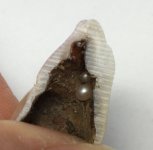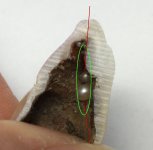You are using an out of date browser. It may not display this or other websites correctly.
You should upgrade or use an alternative browser.
You should upgrade or use an alternative browser.
Keshi pearl IN a pearl
- Thread starter jshepherd
- Start date
Purranha
Well-known member
I hope you/Hisano kept those baby keshis and incorporate it into the design!
JerseyPearl
Well-known member
That is like finding a pearl while eating a clam! So cool...and wow the "mud" inside of the soufflé is kind of interesting too...never saw that before...ugly duckling to swan in pearl form. Please post the final product. And please do tell Hisano her designs are really wonderful!
eta: I wonder if the pearls were formed before the "mud" was inserted into the animal.
eta: I wonder if the pearls were formed before the "mud" was inserted into the animal.
BWeaves
Well-known member
That is so cute. I'm guessing those pearls are tiny, but they look so perfect.
KaySD
Member
I hope you/Hisano kept those baby keshis and incorporate it into the design!
+1. That is so cool.
CathyKeshi
Well-known member
That is amazing and wonderful, Jeremy!!!!!!
Pearl Dreams
Pearl Enthusiast
So unusual!
newberry
Well-known member
Cool pearl. I wonder what Hisano will do with the keshi? Thank you for showing us.
Katbran
Well-known member
Wow, very cool ! Thanks for that... I love the pearl Geodes that Hisano makes !
Lagoon Island Pearls
Well-known member
- Joined
- Dec 8, 2009
- Messages
- 2,143
Hisano has sliced A LOT of souffle pearls! There are two little pearls growing inside a souffle!
By virture of that the incidence of occurrence is low.
I've marked the image for comments.
The red line appears to be the incision along the sac where the pearl was expressed and the mud packed. Inside the green line, there's a gap between edges of the cut, bridged by conchiolin, then aragonite on successive layers. For whatever reason by prolapse, affinity or infection... pearls formed at that level. Most likely due to granular tissue nucleation aka scar.
At first glance, I thought these may have been present in the pearl sac only to end up in the muck, but two close together and fused along a scar line suggests they formed subsequent to the packing. Likewise, they are not "nacred" to the pearl like a mabe or a blister, insomuch as fused to the lining by their pearl sac.
They're technically natural although convention would have them as cultural. There was human intervention, but clearly coincidental and unintentional.
An intriguing specimen.
Attachments
CathyKeshi
Well-known member
Just curious; it looks like there's a tiny third pearl, or a bit of nacre, all the way at the top of the cavity, slightly to the left, just outside Dave's "green line" ? May be just a photo artifact?
KaySD
Member
I was wondering about that same thing, Cathy.
Similar threads
- Replies
- 1
- Views
- 531
- Replies
- 2
- Views
- 2K


